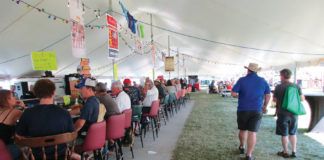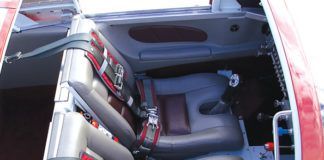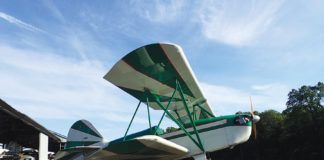It Floats Your Boat
Reader Chet Moen expresses interest in using an outboard powerhead for Experimental aircraft. Back in the late 1960s, when RotorWay came out with its early Scorpion helicopters, they used an Evinrude V-4 powerhead with some degree of success.
My partners and I purchased one of the power systems, adapted it to a VW transaxle in a single-seat race car and competed in Southern California and Baja off-road events, with some degree of success. The two-stroke put out considerably more power per pound than any VW engine at the time, and had a simple belt-driven water pump with a small radiator to keep it cool.
As I recall, the stock Evinrude of the day weighed 115 pounds and produced 115 hp. With advances in technology over the past 40 years, I imagine the power-to-weight ratio of todays outboards might even be better. Readers might take a look and see whats out there today.
Barry Alsobrook
Outboard engines are designed for an operating environment with unlimited quantities of cool (less than 100 F) water. Because of this aspect, cooling water is preheated before entering the cylinder head and block for engine cooling. This preheating is performed in the exhaust collector chamber, where the combustion exhaust first exits the cylinder. This helps cool the exhaust and preheat the coolant; otherwise, the cold water entering the block and the cylinder head will be too cool to maintain a desirable engine operating temperature.
The engine block design is such that it is almost impossible to adapt an air/water radiator to an outboard powerhead of sufficient capacity to cool the outboard powerhead at high power output. I have had some experience with this with both two-stroke and four-stroke outboard powerheads when working with companies and individuals attempting the adoption of outboard powerheads to applications other than outboard motor use. All in my experience failed to make it work.
Liquid-cooled engines designed for use with air/liquid coolant radiators use exhaust ports of small diameter to move the exhaust gases through the cylinder head as rapidly as possible to minimize heating of the cylinder head and block. Outboard powerheads allow the exhaust gases to linger in the collector trunk and the coolant is preheated by the gases. Bob Young
This is in response to Chet Moens letter in the September issue about outboard motors used in aircraft. Back in 1971 while stationed at NAS North Island (San Diego, California), my sons and I would ride our dirt bikes over near Brown Field. One time we heard this really loud high-pitched sound that slowly built to a scream similar to a small jet engine. Upon riding up to the hangar area, we saw this small helicopter tethered at about 6 to 8 feet above ground. After about 10 minutes, it slowly wound down, landed, and shut down.
We approached the group surrounding the helo and asked what was going on. We were informed that they were developing a kit helicopter using a six-cylinder Mercury outboard motor. I believe it was either RotorWay or Robinson, but not being a helo person, Im not sure which. Don’t know what they use now, but they started with an outboard.
Only If You Say Please
After reading the September issue of KITPLANES, I have three items.
1. Please! Give us The Collected Works of Barnaby Wainfan! I can hardly wait! (He did not put me up to this!)
2. Dear Mr. Fritz: As much as I enjoy your articles, could you please give us the locations of your stories? I know that Walter Treadwell is from Livermore, California (KLVK), but you didn’t tell anyone else. And are you ashamed of your home airport? Nice story about the Jabiru, but where are you building it?
3. Dear Ms. Laboda: As an 18-year-old, I took the bus from Minneapolis to Rockford, Illinois, for the 1962 EAA convention. At dawn on my first day there, I saw the most beautiful aircraft I had ever seen-the prototype Wing Derringer (O-235 engine)! While I was standing with the barrier cord cutting into my shins, George Wing came up and gave me (someone who didn’t have two dimes to rub together) a close-up tour of the aircraft. I believe that it was the first public appearance of that aircraft. At least two years ago there was a Derringer here at Livermore, though I have not seen it recently.
John B. Hyde
Bob is not ashamed of his home airport, which is Swansboro (01CL), in Placerville, California.-Ed.
Thorp Catch
Just a quick note that the article on John Thorp was a great one. Only one correction that should be made regarding the caption of the photo on Page 27, showing John putting Clecoes into the tail section of a T-18. Sorry, Im not sure what the craft is, but it isn’t a T-18. It could be a T-211.
Bill Burger
Us, Too
Nexaer
Hi. [Hi.-Ed.] I was wondering what happened to the Nexaer LSA. The last I saw it was in flight testing, then nothing. Jude Steele
We have attempted to contact Nexaer by phone and via email without success. So: No clue.-Ed.




